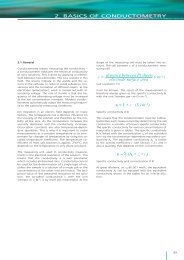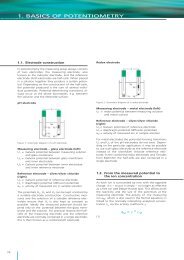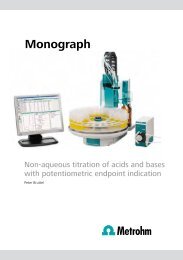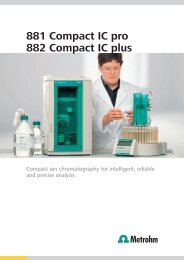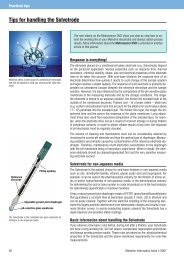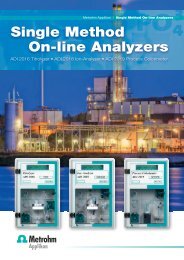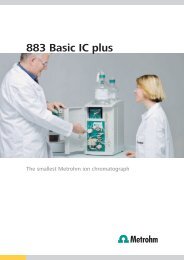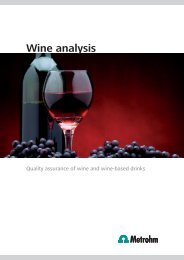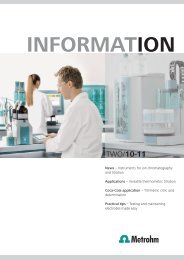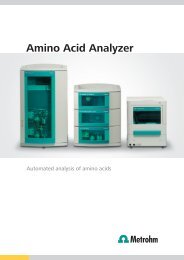Surface Plasmon Resonance with the Autolab SPR ... - Metrohm
Surface Plasmon Resonance with the Autolab SPR ... - Metrohm
Surface Plasmon Resonance with the Autolab SPR ... - Metrohm
- No tags were found...
Create successful ePaper yourself
Turn your PDF publications into a flip-book with our unique Google optimized e-Paper software.
AUTOLAB APPLICATION NOTEAno<strong>the</strong>r option is <strong>the</strong> use of a so-called sensorchip(Pharmacia AB, Sweden) which is a wafercovered <strong>with</strong> a dextran coated gold-layer. Thedextran coating is very suitable to studymacromolecular interactions. Three methods areused to couple ligands:Immobilization of <strong>the</strong> ligand. The ligand iscoupled covalent ei<strong>the</strong>r by amine functionalgroups or by thiol functional groups to <strong>the</strong>dextran layer.Non-covalent binding of biotinylated ligand to astreptavidin-immobilized sensor chip. Due to <strong>the</strong>severe biotin-streptavidin interaction, it ispossible to regenerate <strong>the</strong> surface <strong>with</strong>outbreaking <strong>the</strong> non-covalent biotinstreptavidinbond. This method is suitable to couple syn<strong>the</strong>ticDNA molecules to <strong>the</strong> surface.Immobilization of capturing antibodies. Capturingantibodies are used when <strong>the</strong> activity ofantibodies is reduced by <strong>the</strong> immobilizationprocedure. Detection of antigens is achieved inthree steps. Firstly, immobilization of <strong>the</strong>capturing antibody (for example anti-Rabbit AntiMouse-Fc). Secondly, binding of <strong>the</strong> secondantibody (a mouse antibody) by <strong>the</strong> capturingantibody. Thirdly, specific binding of <strong>the</strong> antigenby <strong>the</strong> second antibody. Regeneration of <strong>the</strong>surface will usually break all non-covalentinteractions.These methods have been used to studybiomolecular interactions intensively. Examplesof biomolecular interactions are:peptide-antibody interactionprotein-antibody interaction, epitope mappingprotein-DNA interactionprotein-polysaccharide interactionprotein-virus interactionprotein-cell interactionprotein-T cell receptor interactionantibody-antibody interaction, capturing antibodyDNA-DNA interactionElectrochemical <strong>Surface</strong> <strong>Plasmon</strong> <strong>Resonance</strong>(E<strong>SPR</strong>)Through <strong>the</strong> combination <strong>with</strong> an <strong>Autolab</strong>Potentiostat, <strong>the</strong> <strong>Autolab</strong> <strong>SPR</strong> instrument is verywell suited for E<strong>SPR</strong> experiments, where <strong>SPR</strong>phenomena are studied in-situ during anelectrochemical experiment. This combination oftechniques has been described by a number ofdifferent groups for example to study <strong>the</strong>changes in a thin organic film upon change of<strong>the</strong> electrostatic field (or potential of <strong>the</strong>electrode). This technique is thus well suited forbiosensor development, <strong>the</strong> development ofmodified electrodes, electropolymerization, etc.Experimental exampleIn <strong>the</strong> figure below a cyclic voltammogram isshown of toluidine blue in 0.1 M KCl solution. Theexperiment was performed in <strong>the</strong> cuvet of an<strong>Autolab</strong> <strong>SPR</strong> instrument, where <strong>the</strong> gold layer of<strong>the</strong> glass was used as working electrode. A Ptwire was used as counter electrode and aminiature Ag/AgCl electrode as a reference. Thechange in <strong>the</strong> <strong>SPR</strong> resonance angle (or <strong>the</strong>refractive index) indicating <strong>the</strong> adsorption of <strong>the</strong>Toluidine molecule in <strong>the</strong> oxidized state is shownin <strong>the</strong> blue curve. It is clearly visible that uponoxidation of <strong>the</strong> toluidine molecule adsorption on<strong>the</strong> surface takes place (positive change in <strong>SPR</strong>angle). In <strong>the</strong> reduced state, <strong>the</strong> toluidinemolecule is back in solution again.APPLICATION NOTE 10 AUTOLAB INSTRUMENTS ARE DEVELOPED AND PRODUCED BY METROHM AUTOLAB B.V. IN THE NETHERLANDS WWW.METROHM-AUTOLAB.COM




